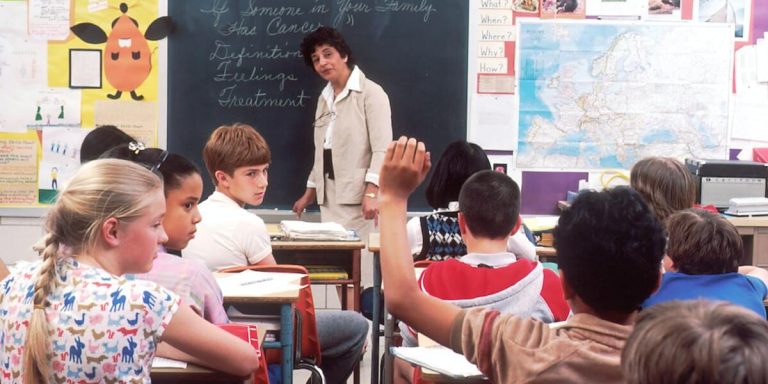New Technology for Teachers: Transforming the Classroom Experience
The introduction of “new technology for teachers” is revolutionizing the education sector, enhancing the teaching and learning experience like never before. From virtual classrooms to AI-assisted lesson plans, educators are embracing modern solutions that transform traditional pedagogical methods into more engaging and effective techniques. This change not only benefits students in terms of improved academic performance but also equips them with essential skills needed in a digitized world.
Moreover, this shift towards technology integration in education makes lessons accessible universally which breaks geographical barriers while promoting inclusivity among diverse learners. It goes beyond ensuring students understand subject matter — it’s about fostering creativity, critical thinking abilities, communication skills and cooperation; all vital competencies for their future pursuits outside school walls.
Did you know?
Augmented Reality (AR) technology is not just for gaming; In education, AR holds the potential to transform teaching by incorporating interactive 3D models into learning materials, offering an engaging way for students to explore complex subjects like anatomy and geography.
Understanding Technology Integration in the Classroom
Technology integration in the classroom is a transformative strategy that’s changing the face of education. With countless new tools and applications available for teachers, it’s crucial to understand their optimal utilization to enhance learning experiences in this digital era.
Incorporating technology into teaching pedagogy not only makes schooling more engaging but also improves students’ overall performance by supplementing traditional methodologies. Take, for examle, interactive whiteboards replacing chalk and duster or virtual reality tours extracting learners from physical confines of classrooms onto historical sites worldwide; such innovations are reshaping conventional educational practices.
No longer just limited to computer labs, 21st century schools increasingly have tech-devices right on pupils’ desks – be it tablets for personalised tutoring or AI-based educational software simulating scientific experiments safely. Meanwhile educators leverage these novel methods as an extension of themselves – with administrative apps managing attendance records digitally while online portals provide seamless parent-teacher communication at convenience.
Therefore understanding technological integration isn’t merely about adopting fancy gadgets—it necessitates strategic planning around individual student needs and potential barriers like unequal access to resources among different demographic groups present inherently within classrooms today. By doing so we ensure students attain necessary skills relevant beyond school life whereas teachers remain updated with modern academic trends preparing them effectively towards future-forward instruction delivery techniques.
Key Components of Effective Educational Technology
Embracing new technology for teachers can revolutionize the way we educate children. But let’s not just introduce it into our classrooms thoughtlessly. It is crucial to understand the key components of effective educational technology.
Firstly, technological content and applications should be relevant and suitable for the age group being taught. The apps and platforms utilized need to align with students’ cognitive capabilities, providing a challenge but also ensuring comprehension.
Next in line is interactivity which plays an essential role in learning through tech-based resources. A platform that encourages active learner participation significantly enhances student engagement rates compared to traditional classroom methods.
Technological accessibility cannot be disregarded when picking out new technology for teachers either! With today’s advancements, there are numerous assistive technologies available making digital education platforms reachable by all regardless of geographical location or physical ability.
The fourth element pertains to adaptability – i.e., how well does your chosen educational software adjust according to individual learners’ skills? Adaptive learning systems are increasingly supporting personalized instruction based on each child’s unique needs – from pace adjustment functionalities down at text level modifications!
Overcoming Challenges with New Technologies for Teachers
Integrating new technology into lesson plans has never been more critical. With the digital age in full swing, teachers must be equipped with modern tools and techniques to ensure a versatile learning environment for students. However, many educators face challenges when it comes to effectively incorporating these advancements into their classrooms.
The first step towards overcoming this hurdle is gaining a detailed understanding of the available technologies. Exploring various educational software, apps and platforms designed specifically for classroom use can provide an insight on how they function and what benefits they offer. Reading reviews from fellow educators or taking part in online forums can also assist in selecting appropriate resources that best suit one’s teaching style.
Another major challenge faced by teachers involves addressing disparities due to unequal access of technology among students based on socio-economic factors or geographical limitations. These gaps may hinder some children from benefiting fully from tech-integrated lessons.
One practical solution could involve liaising with school authorities or local communities leveraging initiatives which aim at providing necessary technological assistance like low-cost devices and affordable broadband internet services.
Moreover, ongoing professional development programs can greatly aid new technology implementation process for teachers as well as overcome potential fears related to its usage.
These might be informational webinars discussing latest EdTech trends; interactive workshops demonstrating hands-on activities using certain gadgets/applications; courses offering certificates upon successful completion etc., all giving opportunity not just learn but grow professionally too!
Innovative Tools Shaping Modern Teaching Practices
At the cutting edge of modern teaching practices, innovative tools are swiftly transforming the landscape. From immersive virtual reality to interactive online platforms, these new technologies for teachers are being embraced with open arms due to their enormous potential in enhancing both teaching and learning experiences. The integration of technology into everyday classrooms isn’t just a futuristic aspiration; it is happening right now in 2023.
These tools offer multifaceted advantages ranging from increased student engagement to ease in tracking progress and performance metrics. Teachers can leverage advanced software applications or digital whiteboards to simplify complex ideas into understandable formats – making subjects more accessible and engaging for students. Moreover, augmented reality apps provide an unparalleled hands-on educational experience that may not have been feasible previously without such technology advancements.
This evolution towards tech-enabled instruction does not undermine traditional pedagogy but rather serves as an enhancement promoting a blended approach wherein teachers skillfully merge tried-and-true methodologies with emerging technological resources. As we continue on this trajectory of systematic change within our education system globally, there’s no doubt that these exciting innovations will play a significant role in shaping future generations’ minds.
Utilizing Interactive Whiteboards for Engaging Lessons
In today’s digital learning environment, “new technology for teachers” is a buzzword that cannot be ignored. One such example of this cutting-edge innovation is the use of interactive whiteboards in classrooms.
Interactive whiteboards revolutionize classroom teaching methodologies by allowing information to be conveyed through dynamic and engaging presentations. Compared to traditional chalk-and-talk methods, using these boards instills more zest into daily lessons while boosting overall student engagement.
A standout feature of interactive whiteboards lies in their ability to make mundane topics captivating with just simple integration. Whether it’s Math or English literature, subject matter comes alive when narrated via colorful graphics and animations on big screens—making education not only informative but also entertaining!
The promising aspect about integrating new technology for teachers like interactive boards is how they promote collaborative working environments among students. For instance, group projects can leverage the touch response capability encouraging teamwork – each member gets an opportunity to contribute actively during discussions.
On top of being visually appealing tools suitable for various age groups and subjects alike; there are additional benefits too! Interactive Whiteboards pave way toward better retention rates as compared with traditional teaching aids due them involving multiple senses simultaneously – sight hearing plus tactile participation all rolled into one immersive experience which ultimately leads improved memory recall performance over time span.
Implementing Learning Management Systems to Facilitate Education
In 2023, with the proliferation of technology in education, learning management systems (LMS) stand at the forefront. They are a prime representative of new technology for teachers that’s reshaping modern teaching practices.
Employing an LMS is more than just merely adopting new tech – it’s about enhancing interactivity and offering tailored learning experiences. Here we delve into how integrating these platforms can facilitate superior educational methods.
One way schools benefit from implementing an LMS is through efficient content distribution. Teachers use these platforms to share assignments, grades, feedback and important dates seamlessly. It transforms classrooms into digital hubs where information flows unimpeded between teacher-student and peer-to-peer alike.
Moreover, utilizing such innovative tools gives educators power over course customization like never before seen in traditional formats – enabling them to create individualized courses suited best for each learner’s needs.
Another advantage lies within assessment automation exclusive to using this specific new technology for teachers—engaging online quizzes or tests help evaluate student progress without requiring excessive marking time on part of faculty staff members; results get tabulated instantly providing immediate insights helping gauge understanding levels among participating students accurately plus efficiently which ultimately leads towards improved instruction quality overall!
Measuring the Impact of Technology on Student Achievement
The integration of new technology in education has become a critical aspect for teachers globally. It plays a pivotal role not only in facilitating the teaching process but also significantly influences student achievements. The advancements we’ve witnessed thus far, ranging from interactive whiteboards to learning management systems and educational apps, have transformed modern classrooms beyond recognition.
Measuring the impact of such technology on student achievement is an ongoing journey that requires continual observation and analysis. By leveraging these digital tools effectively, teachers can monitor progress more accurately than ever before – paving the way for personalized instruction tailored to different students’ needs.
Several studies suggest there’s substantial evidence linking engagement with technological tools with improved academic results – something that emphasizes our shared responsibility as educators and parents alike to incorporate this into mainstream pedagogy properly. As we venture deeper into 2023, it becomes clear just how crucial mastering this art will be for future generations’ success amid shifting occupational landscapes necessitated by rapid digitization worldwide.
Analyzing Data-Driven Results from Tech-Based Teaching Methods
In this modern era, the role of “new technology for teachers” has become pivotal in structuring educational methodologies. Technology integration in education is not just about using high-tech tools but also carefully assessing how these tools affect student achievement.
The process begins with implementing tech-based teaching methods into the classroom environment. For instance, utilizing tailored digital learning platforms or apps that cater to individual students’ needs and preferences can offer personalized teaching experiences—an approach far removed from traditional one-size-fits-all teaching strategies.
Accompanying these new techniques should be a consistent study on their impact through data-driven results analysis. The emphasis here lies within two factors: valid metrics and an impartial interpretation of those figures. Teachers must learn to focus more on measurable outcomes like test scores improvement, enhancement in problem-solving skills among others as key indicators rather than relying solely on subjective evaluations such as class participation rate or personal biases.
Case Studies: Success Stories of New Technology Adoption by Teachers
In an era where technology is revolutionizing every other sector, it’s no wonder that our education system too has been significantly transformed. Over the years, evolving teaching methodologies coupled with new technologies have enhanced student learning outcomes.
Consider Mrs Smith’s 2nd-grade class in Texas. Her introduction to educational games on tablets saw a noticeable improvement in her students’ math scores over one academic year. Implementing this form of interactive learning turned out to be more engaging than traditional methods and fostered faster comprehension.
Then there’s Mr Johnson from Chicago who started using online polls for classroom quizzes instead of paper ones. The immediacy allowed for real-time feedback which he used directly to improve his lessons based on what the kids were struggling with day-to-day when understanding was freshest.
Moving westwards towards Los Angeles, you find Ms Fernandez introducing virtual reality as part of science curriculum giving visual learners an edge while also making hard concepts easier via simulations leading to higher retention rates among her students compared previous years.
Conclusion
Undoubtedly, the advent of new technology for teachers is paving way for an enhanced and engaging classroom experience. These tools are not merely high-tech additions to their teaching arsenal but a means to encourage interactive learning, promote critical thinking skills, and cultivate innovative minds in our young learners.
Our journey doesn’t end here! To further explore this dynamic field of childhood education along with more enlightening resources designed specifically for parents and educators alike, feel free to wander through our website. Our mission extends beyond providing information; we aim at building a supportive community focused on shaping better future leaders.
Happy reading!







